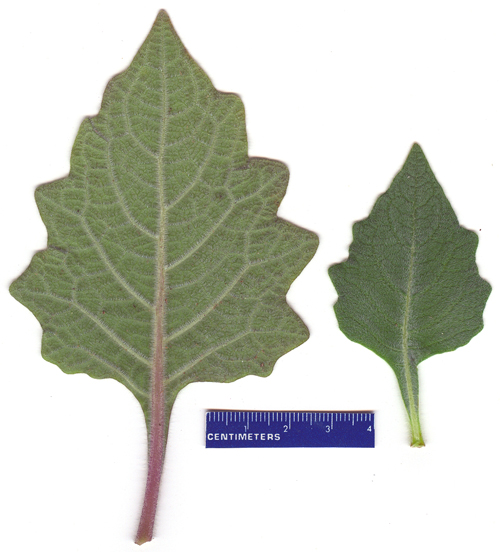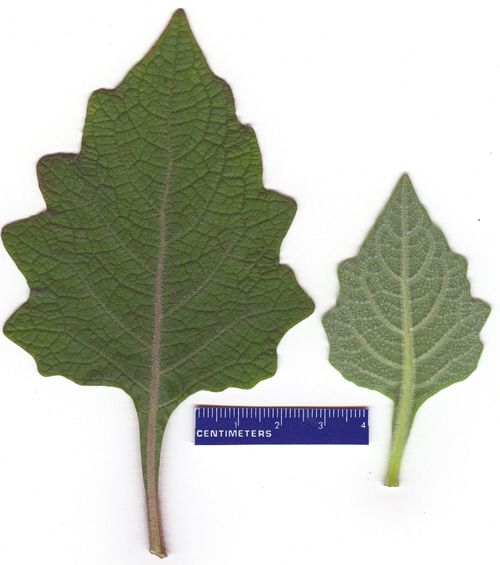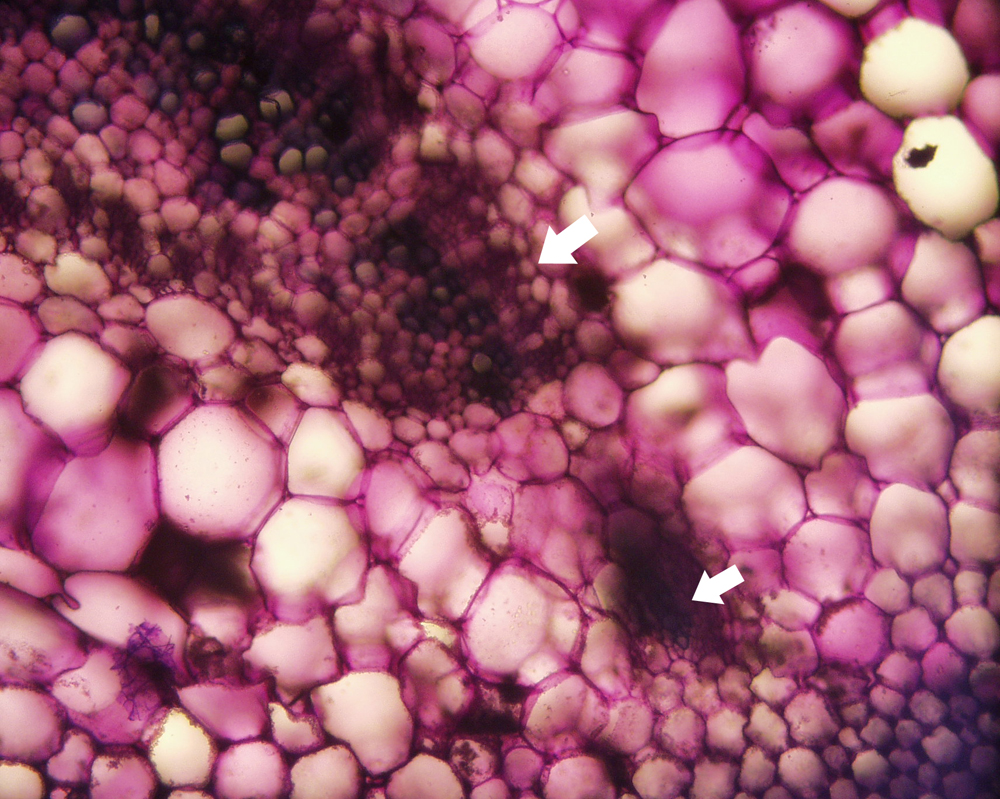Link to Floral Phenology of Jaltomata grandiflora
Jaltomata grandiflora (Robinson and Greenman) D'Arcy, Mione & Davis |
Mexico |
updated Aug 2023 |
| Link to Jaltomata homepage | The information on this page may be cited as a communication with professor Thomas Mione, Central Connecticut State University, Biology Department, Copernicus Hall, 1615 Stanley Street, New Britain, Connecticut 06050-4010, United States of America. | Link to Jaltomata of Mexico and Central America |
| Figure 1. Flower in pistillate phase (anthers undehisced, filaments very short). Nectar is produced by pistillate phase flowers but does not show in this photo. In lower left corner a 2nd flower shows only calyx and ovary (note disk around ovary is lighter). Photo by TM | Figure 2. Flower, hermaphroditic phase (anthers have dehisced and filaments have elongated). Note nectar (clear) where corolla and androecium meet. Photo by TM Link to Floral Phenology of Jaltomata grandiflora |
 |
 |
| Figure 3. Jaltomata grandiflora, fresh leaves of cultivated plant. Left leaf among the largest (few leaves were this large) and underside is up. Right leaf is the most common size encountered and has upper side up. Scan by T. Mione July 2009 | Figure 4. J. grandiflora, fresh leaves of a cultivated plant. The left leaf is the same leaf shown in the photo at left except here the upper side is showing. The right leaf is the same as the leaf show in the photo at left except here the underside is showing. Scan by T. Mione July 2009 |
| Figure 5. Jaltomata grandiflora fruit (photo by Thomas Mione in Connecticut August 2009). |
Figure 6. Stem cross section, outer edge. |
Figure 7. Stem cross section showing some secondary growth. |
Description mostly based on living plants from seed provided by T. Davis IV of T. Davis 1114.
| Figures on this web page | ||
| Habit & Height | Perennial, suffrutescent, to 85 cm high when cultivated for research in Connecticut |
9 |
| Young Branches | light green, velutinous with a dense covering of soft, whitish, 1.2 - 1.6 mm long multicellular finger hairs; solid | 5, 6, 9 |
| Older Branches | purple, hollow internodes, pentagonal in cross section; periderm forming on oldest (lowest to the ground) stems making the lowest (oldest) parts of the stem brown and nearly terete | 5, 7, 8, 9, 14, 15 |
| Leaf Size | 4.3 - 4.6 cm wide, 5.15 - 5.6 cm long | 3, 4, 9, 14 |
| Leaf Shape | ovate, undulate | 3, 4, 9, 14 |
| Leaves | adaxial face bearing evenly distributed, erect multicellular finger hairs 0.8 - 1.28 mm long, sometimes gland-tipped (fresh material) the terminal droplets not viscous; abaxial face bearing a velutinous, dense covering of soft, white, multicellular finger hairs (velvety, visibly and to touch). Leaf vesture most dense on (and leaves therefore whitest on) primary, secondary, tertiary and quaternary veins. On primary veins hairs about 1.2 mm long. Leaves of seedlings having abundant gland-tipped finger hairs (all hairs of young seedlings are gland-tipped, see figure below). Leaves lighter on abaxial face, on both pressed specimens (including the holotype) and live specimens; adaxial face darker green with primary vein markedly lighter than rest of blade. | 2, 3, 4, 9, 14 |
| Flowers Per Inflorescence | 2 or 3 | 5, 14, 15 |
| Peduncle | 9.5 - 10.5 mm long | 5, 14 |
| Pedicel | 11 - 15 mm long | 5, 14 |
| Calyx at Flowering | green and 17 mm in diameter, lobe radius 8 mm, sinus radius 4.6 mm. |
1 |
| Corolla shape and size | rotate, 3.4 - 3.8 cm in diameter, |
1 |
| Corolla lobes/lobules | 5-lobed, or 10-lobed with 5 inconspicuous lobules | 1 |
| Corolla color and hairs | green; the face that pollinators encounter is densely pilosulose with droplet-tipped finger hairs | 1 |
| Stamens | 5.8 - 6.8 mm long. Filaments, slender part pubescent on lowest third (to 1/2 if you include the expanded base). | 1, 2 |
| Anther length & color | Anthers 3.0 - 3.2 mm long by 2.3 - 2.5 mm wide; light yellow; on herbarium specimens 1.71 - 2.07 mm long. | 1, 2 |
| Pollen Grains | 83,000 - 110,000 per androecium, 42.5 - 46.25 µm in diameter | |
| Stigma | Stigma overhead dimensions (living flowers) 1.04 - 1.52 mm by 0.8 - 1.08 mm; 0.72 - 1.02 wide when measured looking straight down at pressed specimens. |
1, 2 |
| Disk around ovary | Yes | 1 |
| Style length | 4.5 - 6.2 mm long | 1, 2, 14, 15 |
| Ovules per ovary | 192 - 285 | |
| Nectar | Clear (translucent), collects where corolla and androecium meet, both during pistillate and hermaphroditic phases. I measured 0.72 to 1.32 microliters of nectar in pistillate phase flowers in 2009 on cultivated plants in Connecituct (volumes were determined by measuring the nectar in microcapillary tubes, given 10 microliters fill tube to 26.5 mm long) | 2 |
| Herkogamy | stamens and stigma are a few mm apart during hermaphroditic phase | 2 |
| Protogyny | Yes, anthers remain closed the first day the flower is open | 1 |
| Fruit color (at maturity) and size | Fruits (fresh) purple (never black, see photo above), oblate in cross section, to 12 mm long X 17.8 X 19.2 mm wide. Fruits fall free of parent plant at maturity usually without, but sometimes with, the calyx and pedicel; ripening is sometimes completed on the ground. | 5, 15 |
| Calyx at fruit maturity | to 25 mm diameter | 5, 15 |
| Infructescence | 1 or 2 fruited. Pedicel and calyx of mature fruit becoming brown and dry/papery as fruit ripens (see photo above). | 5, 14 |
| Seeds | 1.57 - 1.89 X 1.38 - 1.53 X 0.63 - 0.69 mm, 147 - 186 per fruit from plants grown in CT | |
| Chromosome number | 2n = 24 |
|
| Growability in Connecticut, USA, outdoors | Easy. In a pot or in the ground. Seeds planted in April give flowers in July. Seeds stored in the refrigerator for years germinated in only 6 days (planted 1 May 2003, seedlings observed 7 May 2003) and 8 days (planted on potting mix on window sill 11 Apr 2007, seedlings observed 19 Apr 2007). | 1, 2, 3, 4, 5, 6, 7, 8, 9, 10, 11, 12, 13, 14, 15 |
| How long does it take from flower to ripe fruit? | A flower open on 2 August gave a ripe fruit 9 September 2009. | |
| Self-Compatible? | Yes. A single plant was grown in 2009 and it set fruit containing normal seeds. |
Diagnostic Features: No other Mexican species is similar. Jaltomata grandiflora is densely velutinous, has a peduncle shorter than 11 mm, a corolla 34 - 38 mm in diameter (hermaphroditic phase), undehisced anthers longer than 2.8 mm, and a large stigma (1.0 by 1.5 mm in overhead view). The pollen diameter (42.5 - 46.25 µm) is larger than any other Jaltomata species studied to date. Distribution and Habitat: This species is rare: only about three collections have been made, all from the same locality. The first was the type and the other two were by Tilton Davis IV (776, 1114, 1177). The rarity of this species is of special concern because it is closely related to several species of Jaltomata that bear fruits used for food by humans. |
Basionym: Saracha grandiflora Robinson and Greenmann, Am. J. Sci. ser. 3. 1895. Type: MEXICO. MICHOACAN, hills near Patzcuaro, 22 July 1892, C. G. Pringle 5273 (Holotype: GH!; Isotype: VT!).
Novon 2(3): 190-192. 1992.
Uses and Local Names: unknown.
Additional Specimen
Examined. MEXICO. MICHOACAN:
Patzcuaro area, 0.65 to 1 mile past microwave tower (1.8 miles
past Los Tanques Pueblo) on rd. from Patzcuaro to Tacambaro,2072 m, pine-oak forest
with ferns, moss, bromeliads, lichens, rocky soil, plants sparse;
jump fence and enter area with trees, right hand side of rd.,
24-25 Jul 1977 for Davis 776
(MO) which specifies Rt. 120 to Santa Clara from Patzcuaro; 3
Jul. 1982 for Davis
1114 (MO, greenhouse grown specimens at
COLO,CONN,MEXU, and VT as T.Mione 454); 15 Aug. 1984 for Davis 1177 (MO).
| Figure 8. Jaltomata grandiflora stem cross section where stem was widest (near the ground). Secondary xylem is shown in blue (on left). Secondary phloem is shown in purple having rows of cells lined up with those of the secondary xylem. Xylem and phloem rays appear to be parenchyma cells. Fibers (dark blue) are toward upper right and appear to be in cortex. When sectioned this stem was 10 mm diameter and brown, the brown being the outer surface of the periderm (cork), as shown in the photo below. Plant raised by T. Mione, sectioning and photo by Sarah Saunders September 2009 at Central Connecticut State University. |
| Figure 9. Jaltomata grandiflora; note old leaves are fading (light green) and new leaves (dark green). (Plant in photo was grown and photo was taken, summer 2009, by Thomas Mione). |
 |
| Figures 10 & 11. Petiole cross sections, above and below. Note the presence of three vascular bundles. The larger vascular bundle is crescent shaped and is the only vascular bundle shown in the photo below. Above, it is pointed out by the left arrow. A pair of much smaller vascular bundes flanks the larger vascular bundle; one of these smaller vascular bundles is pointed out by the white arrow at right in the above photo. Collenchyma in lower right of upper photo. By hand with a razor blade August 2009, stained with toluidine blue, sectioning and photos by T. Mione. |
| Figure 12 (above), 13 (upper right) | Gland-tipped finger hair of seedling. These are 3-celled (one hair out of about 20 had 4 cells) and uniseriate. Only the terminal cell has dense cytoplasm (stained with neutral red); the other cells do have nuclei, easily seen with phase contrast (not shown). The hairs seen were 0.37 to 0.62 mm long, and all looked like this. The youngest non-cotyledon leaves were observed, and were velutinous with hairs like this. Note that the terminal cell is rounded at its tip, and is markedly wider than the neighboring cell. Observations (with a compound microscope) on seedling hairs were again made in 2007: hairs observed were 2-celled, 0.11 to 0.19 mm long, the terminal cell bulbous. Both cells densely cytoplasmic. Photo and observations by Tom Mione. |
| Figure 14. Jaltomata grandiflora, unripe fruits, the one on the left with persistent style. Calyx on top of each fruit. ( Photo by T. Mione) |
| Figure 15. Jaltomata grandiflora fruit with persistent style, photo by Thomas Mione in Connecticut August 2009. |